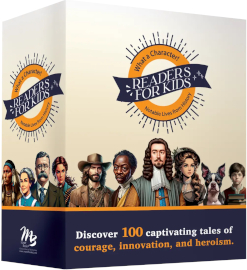What A Character! Notable Lives from History is a series of 10 books, nine featuring 10 stories each about famous or notable people, and one featuring 10 tales of animal heroes. Almost all stories relate to American history, making this series an excellent supplement to use alongside the study of U.S. History. Master Books, the publisher of the series, includes correlations for using the stories in conjunction with other books they publish, particularly the America’s Story series (Volumes 1, 2, and 3).
The books can be purchased individually (as paperbacks, audio downloads, or PDF ebooks) or as a boxed set of paperback books. Their titles are:
- Heroes of Early America
- Heroes of the War for Independence
- Famous Pioneers and Frontiersmen
- Famous Women in History
- America’s Famous Spies
- America’s War Heroes
- Amazing American Presidents
- Famous American Statesmen
- Inventors and Scientists
- Extraordinary Animal Heroes
Written for students in grades four through eight, the stories can be read by students on their own or used as read-alouds. I checked the reading level using several samples, and the result was usually around the sixth- or seventh-grade level. The sentences are relatively short, but there are many proper nouns for people and places. To assist students, the books define challenging vocabulary words in boxes next to where the words appear, and there’s a glossary at the end of each book with these words and definitions all in one place.
Every book begins with an introduction, and a few of the books insert short articles of a broader nature. For instance, America’s Famous Spies has articles on the American War of Independence, the Civil War, and World War II to provide context for the activities of the spies. The stories in Extraordinary Animal Heroes are arranged to follow four articles on World War I, The Alaskan Black Death, World War II, and The Korean War. In these instances, students should probably read the stories that follow each article, but otherwise, the stories can be read individually rather than in sequence.
The stories emphasize positive character traits and values that inspired these people (and animals) to do great things. Stories about those whom we know were motivated by their Christian faith include that aspect. For example, in the story of Florence Nightingale in Famous Women of History, we read,
One young man, Richard Milnes, begged Florence to marry him. Florence did love Richard but would not give up her dream of being a nurse. Florence felt God was calling her to a life of service, not one of parties and ease. Richard finally told her she had to choose between her work and him. With tears, Florence told him, “I was born to do a special work. I must give up everything else — even you, Richard.” She wrote in her diary, “I am thirty, the age at which Christ began his mission. Now no more childish things, no more vain things, no more love, no more marriage. Now Lord, let me think only of Your will.” Her family was shocked and disappointed in her (pp. 54-55).
The stories are based on history, sometimes quoting from primary sources, but more often drawing from other children’s books written about the characters, with frequent endnotes crediting the latter. Because of the storytelling style and the use of other storybooks as sources, the various storytellers have inevitably created some of the material to flesh out what can be documented historically. I wouldn’t have been so aware of the author’s reliance on other storybooks if she hadn’t included numbers for endnotes within the stories. Most children’s storybook authors do not provide such clear attribution of their sources.
 The stories feature a full-color illustration on almost every page. I noticed that most of the characters are portrayed in the images as being very attractive, too much so to be realistic. Looking for the name of the illustrator, I discovered that the images were all “AI-generated at shutterstock.com.” The nearby image of Daniel Boone is typical of the style—not like clip art but developed specifically for this series. While not always historically accurate, the images enhance the books and should appeal to young readers.
The stories feature a full-color illustration on almost every page. I noticed that most of the characters are portrayed in the images as being very attractive, too much so to be realistic. Looking for the name of the illustrator, I discovered that the images were all “AI-generated at shutterstock.com.” The nearby image of Daniel Boone is typical of the style—not like clip art but developed specifically for this series. While not always historically accurate, the images enhance the books and should appeal to young readers.
Summary
Children are likely to enjoy learning history through these stories that flesh out characters and bring history to life.













